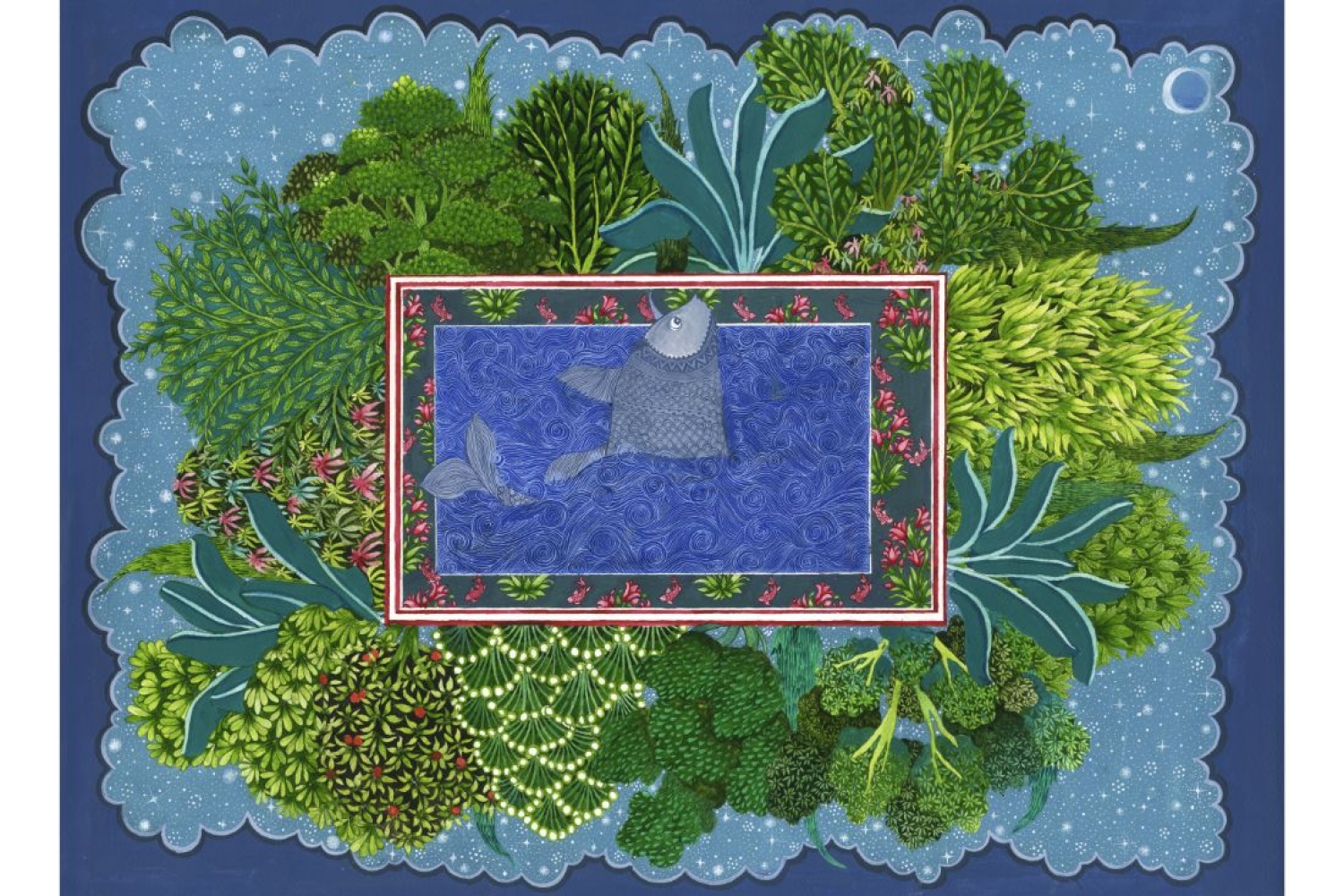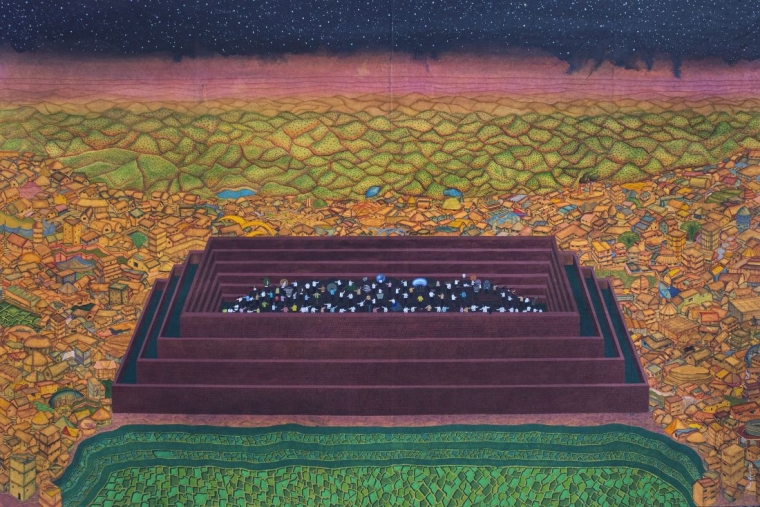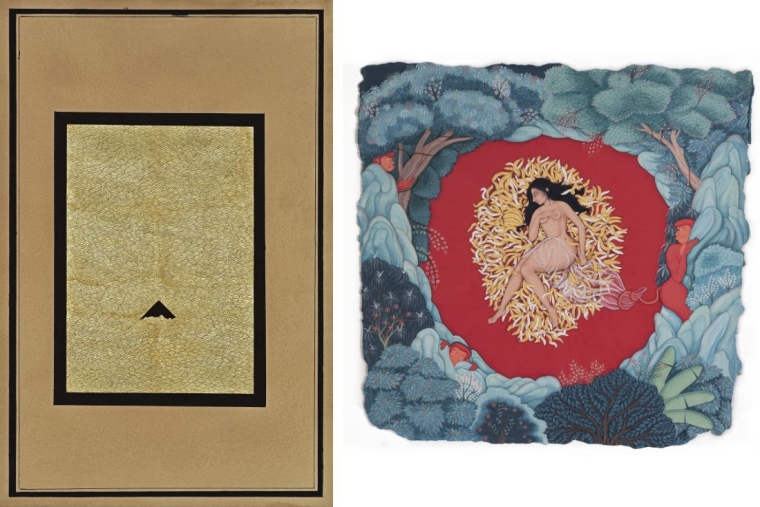

When we think of miniature art, traditional depictions come to mind: religious motifs, Mughal period and paintings of kings. Khushboo Jain's curation of the art exhibition, Off Margins, at Art and Charlie challenges these conventional perceptions, expanding the horizons of miniature art in the postmodern era. By delving into new subjects and formats, Jain's exhibition aims to revitalize the practice of miniature painting, once in decline, and propel it into the contemporary spotlight. Moreover, Off Margins sparks a crucial dialogue on the colonial burden of the term "miniature," originally imposed by the British, and seeks to reclaim its cultural significance. Off Margins explores the decolonization of this art form by uniting artists from South Asia, shedding light on the revival of traditional miniature practices.
Rooted in Jain's upbringing in Jaipur, one of the bastions of traditional miniature art, the exhibition also blossomed from a deeply personal space. In a conversation with Jain, we delve into her profound connection with miniature art and the meticulous curation process behind Off Margins.
Artists in the Exhibit
Miniature paintings known for their intricacy, high degree of detail, technical precision and bright pigments, traditionally adhere to defined folios within margins or borders. However, contemporary artists today aren’t confined to the same boundaries, margins, or history. Which is also why the exhibit is named ‘Off Margins.’
Additionally, while miniature works in contemporary times suggest a stylistic evolution of the art form, denoted by terms like “neo-miniature,” the persistent use of the term “miniature” echoes colonial influences. Thus the exhibit prompts a question whether the term miniature should be given a new name. Today artists are breaking new ground and renewing the miniature art form through experimentation with form, techniques, materials, iconographies apart from new themes and narratives.
Divya Pamnani, for instance, has brought her own rendition to the ancient Indian games. She has brought a playful aspect to the miniature works with subdued colors. We have Laxmipriya Panigrahi, whose practice is largely influenced by her shift from Odisha to Delhi. And it's interesting how she's trying to capture a sense of personal encounter with the ever-changing cityscape that she observes. What's interesting about her work is also the fact that her miniature painting is not limited to say a traditional Wasli or traditional stone pigment. She has used watercolors and some of her paintings are made on canvas using oil paints. It's interesting how painters are not restricting themselves to the same mediums and materials, and still preserving the miniature semantics and stylizing the approach to painting.
Then, we have artists like Gargi Chandola, who brings an interesting nuance of feminism with a touch of humor, which again is a very interesting subject that you wouldn't normally find in a traditional miniature work. And then we have Arslan Farooqi, who is an artist based out of Pakistan, and he tries to bring in the amalgamation of sound, noise and music through compositions taken together with custom and faith. He tries to bring in a lot of social-political aspects that he sees in his country and render that using a very minimal stylizing. Then, we have artists like Ravi Kumar Chaurasia, who are trying to bring in aspects of dual transformation due to development. Ravi's paintings are not limited to a small scale. He's gone up to a 6x7. A lot of different aspects of exportation with miniature art floods the exhibition.
Each artist, through their unique experiences and interactions, has contributed to the renaissance of this art form. The new wave of contemporary artists marks a resurgence of interest in miniature paintings, reconnecting with our indigenous roots and traditions. The artists underscore the dynamic and evolving nature of miniature painting in the contemporary art world. These contemporary expressions are set to inspire future generations within the same lineage, promising a sustained legacy of miniature art.
Relationship with Miniature Art
Being from Jaipur, miniature paintings have been a part of my life. Since I belong to a Jain family, a lot of our scriptures and paintings in the temples would have them. There was a point in my early teen years, where I shifted my painting style to a more miniature one. I think it was in one of these competitions where the jury came up to me and they really appreciated my work. But at the same time, they left with a note that ‘you should consider doing something more modern because this traditional miniature style is really not popular. They're just seated well within the museum as something old.” I think this instance from childhood and my upbringing is something that has brought me to this exhibit.
Everytime I visited art galleries, I often noticed an absence of miniature works so I thought of bringing it forth. BN Goswamy's books and his interviews, his panel discussions in Jaipur Literature Fest have really sort of brought in a sense of inspiration to my curatorial journey. Having an educational background in history, studying and researching miniatures, along with observations captured from working within and with people from the Middle Eastern region in my prior role, further contributed to my engagement with miniatures.

History of Miniature Art
Miniature art has shape shifted for centuries. They can be traced from the 8th century under the reign of Palas of Bengal. They were painted even before paper was introduced, on the very limited space of palm leaves.
When the Mughal Empire came into power, the art form flourished. In fact, most of the miniature works that you may see, even enshrined in our museums, are essentially from the Mughal Empire. Having said that, the moment the Mughal Empire started to decline, so did the miniature art form as such. When the period of colonization came, given the Western influences, and added value judgment, the miniature paintings took a backseat. The exhibit is essential to capture the kind of revival and resurgence that we're seeing in the miniature art form.
In my walk-throughs, I met many people from all walks of life, who wanted to know more about the traditional miniature paintings, because they had no idea what it was. So I think through this exhibit, it was very important to capture that traditional historical sentiment of the miniature paintings, and address how it is being reformed and revived in today's context.
From Painting to Curation
Painting essentially is something I've done for myself. There wasn't a professional aspect for me in painting. I have been interested in studying history, culture and everything that art provides. Subjects pertaining to history and culture are all my favorites. For me, coming from both an artist and a curator perspective, art is more hopeful than politics, curating is a hopeful endeavour, and art provides a space to talk about issues, where politics fail to do so. It's always about capturing some sociopolitical context and providing a sense of discourse as we're also doing with this exhibit. As a curator, I see myself as a bridge of connecting the world of arts to the mainstream audience. I think the entire aspect of providing a thematic discourse, and showcasing and collecting all of these artworks and providing it in front of the eyes of people is something I really find joy in.
Curatorial Process for Off Margins
I process much of my curatorial practice through research, writing and public and artist interrogations. My curatorial practice extends beyond exhibition, selection, and display; it's a deliberate effort to reflect cultural practices that engage with contemporary social concerns.
I was essentially writing a piece dwelling into the revival of miniature artwork. I was in discussion with one of the artists in Lahore, Pakistan. In that moment, it also struck me as to why is the term ‘miniature' still being associated with the art form, especially in the contemporary context, which is also something we're trying to put through to this exhibit. Going back to the time when the colonizers came, the term ‘miniature’ was labeled by them. Afterall the term “miniature” is a colonial creation, implying a sense of “smallness” for the art form. By associating the term with size, the British sought to subordinate the art, diminishing its cultural and artistic value.. It's almost like you think of miniature and you would think it's a small painting. Miniature artworks, each stroke and detail are imbued with profound significance, beckoning the viewer on a journey of discovery and revelation. The unfolding narrative gently leads the eye from one intricately rendered detail to another, each contributing to a grander story that transcends the artwork’s physical limits. The paints are derived from minerals and stones.
Especially in the contemporary context, the art form is now labeled under the term called neo-miniatures. This essentially comes from Pakistan’s National College of Arts. The National College of Arts is essentially the only standalone institute that teaches miniatures. And a lot of these contemporary artists began to come up through that institute essentially. Given the fact that the contemporary works are named after neo-miniatures, it still tends to hold the similar colonial burden that I was talking about. Again, all of those aspects are something that I also wanted to look into.

Words Paridhi Badgotri
Date 08.04.2024